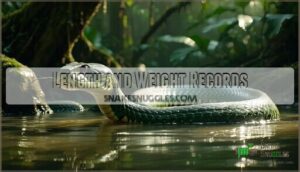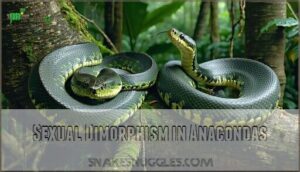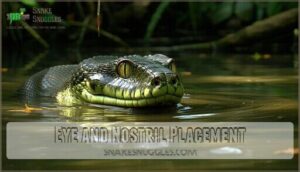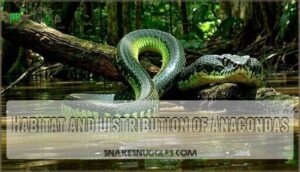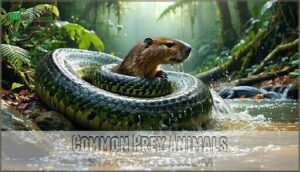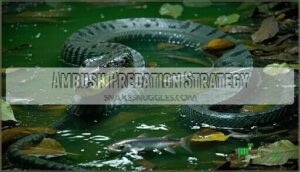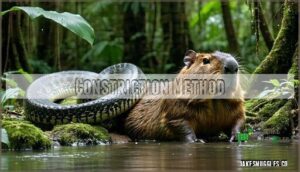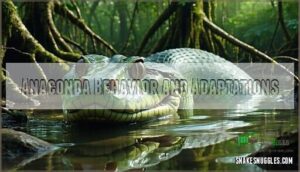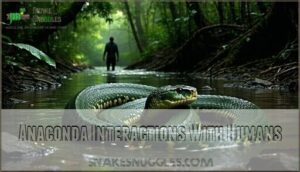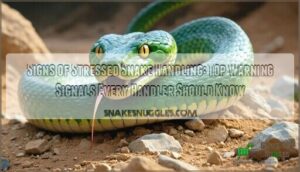This site is supported by our readers. We may earn a commission, at no cost to you, if you purchase through links.
 You’re looking at the world’s heaviest snake when you encounter an anaconda. These massive constrictors can weigh over 500 pounds and stretch beyond 20 feet long.
You’re looking at the world’s heaviest snake when you encounter an anaconda. These massive constrictors can weigh over 500 pounds and stretch beyond 20 feet long.
They’re not venomous—instead, they squeeze their prey until it can’t breathe. Anacondas live in South American swamps and rivers, where they’re perfectly built for water life.
Their eyes and nostrils sit on top of their heads like a crocodile’s. They’ll eat almost anything they can catch, from fish to deer.
After a big meal, they won’t need food for months. These anaconda facts barely scratch the surface of what makes these serpents nature’s ultimate power players.
Table Of Contents
- Key Takeaways
- Anaconda Species and Classification
- Anaconda Size and Physical Characteristics
- Habitat and Distribution of Anacondas
- Anaconda Diet and Hunting Techniques
- Anaconda Reproduction and Life Cycle
- Anaconda Behavior and Adaptations
- Myths and Legends Surrounding Anacondas
- Anaconda Conservation Status and Threats
- Anacondas in Captivity and Research
- Anaconda Interactions With Humans
- Frequently Asked Questions (FAQs)
- What are three interesting things about an anaconda?
- What are the special things about Anaconda?
- What are some cool facts about anacondas?
- What are 5 facts about anacondas?
- What is special about anaconda?
- How fast can anacondas move?
- How big can anaconda swallow?
- How fast is an anaconda?
- What does an anaconda eat?
- How long do anacondas live?
- Conclusion
Key Takeaways
- You’ll encounter the world’s heaviest snake when meeting an anaconda – these massive constrictors can weigh over 550 pounds and stretch beyond 29 feet, making them nature’s ultimate power players in South American swamps and rivers.
- You won’t find venom in anacondas since they’re constrictors who squeeze their prey until it can’t breathe, then swallow animals as large as deer or caimans whole using their incredibly stretchy jaw ligaments.
- You’ll be amazed that anacondas are perfectly built for aquatic life with eyes and nostrils positioned on top of their heads like crocodiles, allowing them to stay nearly submerged while hunting and holding their breath for up to 45 minutes.
- You should know that anacondas give birth to live young instead of laying eggs, with females producing 28-80 babies after a 6-7 month pregnancy, and they can survive for months without eating after consuming a large meal.
Anaconda Species and Classification
When you think of anacondas, you’re actually picturing one of four species in the genus Eunectes.
These powerful snakes are part of the boa family and include the green anaconda, yellow anaconda, dark-spotted anaconda, and Beni anaconda.
Green Anaconda (Eunectes Murinus)
The Green Anaconda (Eunectes murinus) is South America’s largest snake and a true master of survival.
Found in swamps and rivers, its nostrils and eyes rest high on its head, making it perfect for underwater ambushes.
Its constriction method lets it overpower massive prey like capybaras and caimans.
This anaconda species dominates its habitat with a weight exceeding 550 pounds and lengths reaching 29 feet.
Here are some fascinating anaconda facts:
- Eunectes murinus thrives in tropical wetlands.
- It uses stealth to approach prey undetected.
- The largest snake, it swallows prey whole.
- Constriction suffocates prey before digestion.
Yellow Anaconda (Eunectes Notaeus)
The Yellow Anaconda, or Eunectes notaeus, stands out with its golden-banded scales and smaller size variations, reaching up to 15 feet.
Found in South America’s lush wetlands like Paraguay and Argentina, this snake faces habitat threats.
Its diet specifics include small vertebrates and fish, and its powerful constriction makes it a skilled predator, with a conservation status that concerns are growing rapidly.
Dark-spotted Anaconda (Eunectes Deschauenseei)
The Dark-spotted Anaconda (Eunectes deschauenseei) is a fascinating snake species rarely over 3 meters long.
You’ll find it in the Amazon habitat, thriving in seasonal flooding and coastal watersheds. With unique markings providing camouflage, this anaconda blends into the wetlands.
Limited research exists, but here’s what stands out:
- Amazonian savannas are its home.
- It’s water-loving.
- Size rarely exceeds 3 meters.
- Classified as Least Concern.
Beni or Bolivian Anaconda (Eunectes Beniensis)
The Beni or Bolivian Anaconda (Eunectes beniensis) thrives in Bolivia’s Beni and Pando regions, nestled in swamps and tropical savannas.
This unique snake species preys on fish, birds, and even caimans, showcasing its sharp hunting skills.
Although not endangered, the Beni habitat faces threats from hunting.
Protecting these ecosystems is essential for preserving this fascinating anaconda and its remarkable behavior.
Taxonomy and Relation to Other Boas
Anacondas fit perfectly in the Boidae family, sharing some traits with boa constrictors while carving out a space of their own.
Within the Eunectes genus, they’re known for their sheer size and semi-aquatic lifestyle.
Unlike most pythons, which lay eggs, anacondas give birth to live young—an adaptation that helps them thrive in water-heavy environments.
Their evolutionary history links them to other non-venomous snakes, showcasing strong, muscular bodies built for constriction and incredible adaptability.
They may not reach the length of reticulated pythons, but they dominate as nature’s heaviest snakes.
- Fun Fact: Warm-blooded prey is detected using heat-sensing pits near their jawlines.
Anaconda Size and Physical Characteristics
Anacondas are the heaviest snakes in the world, with some growing up to 30 feet long.
Their powerful, thick bodies and olive-green skin with dark oval spots help them blend into swampy environments.
Length and Weight Records
The heaviest anaconda ever recorded weighed an incredible 227 kilograms (550 pounds) and measured nearly 29 feet.
This makes it the world’s largest snake by weight.
While credible measurements confirm their size, exaggerated claims of 40-foot anacondas add a mysterious allure to these giants.
Accurate data collection helps scientists better understand their growth factors.
Green anacondas are basically muscle machines built for survival, blending immense power with stealth in the wild.
Truly remarkable anaconda facts.
Sexual Dimorphism in Anacondas
In terms of sexual dimorphism, female anacondas dominate in size, outshining much smaller males.
This size advantage helps them survive and reproduce. Weighing over 250 kg, females use their strength to guarantee reproductive success.
- Hunting power: Female size supports catching larger prey for energy.
- Mating success: Males compete for larger females.
- Survivability: Bigger bodies handle tough environments, aiding survival.
It’s an evolutionary edge!
Skin Texture and Scale Patterns
An anaconda’s scaly armor serves more than looks—it’s a masterpiece of function.
Its scale morphology blends perfectly with muddy swamps and leafy shadows, creating camouflage patterns that hide it from prey and predators.
The scales’ slight skin iridescence adds a shimmering touch, enhancing its stealth.
Shedding keeps these patterns sharp, while the tactile sensation of their smooth yet rough surface reveals the incredible complexity of snake anatomy and reptile morphology in every detail.
Head and Jaw Structure
The snake jaw is a marvel of nature, built for power and flexibility.
With stretchy ligaments in snakes like anacondas, their skull flexibility allows the bones to expand, making prey ingestion possible—even for animals much larger than their heads.
Teeth morphology adds to this efficiency, acting like backward hooks to grip slippery prey.
This unique snake anatomy guarantees food stays in place as their stretchy jaws engulf it whole, a mouth designed for greatness, showcasing the snake’s remarkable ability to consume prey with its backward hooks.
Eye and Nostril Placement
Anacondas have an evolutionary advantage thanks to their unique reptile anatomy.
Their eyes and nostrils sit high on their heads, acting like snorkels. This aquatic adaptation lets them stay nearly hidden underwater while breathing submerged and watching for prey.
These skilled aquatic snakes use their sensory perception to blend in, making stealth their superpower. It’s a clever design for predator avoidance and ambush hunting.
Habitat and Distribution of Anacondas
You’ll find anacondas in the wetlands, rivers, and swamps of tropical South America, where they thrive in warm, humid environments.
From the Amazon Basin to the Orinoco River, these snakes rely on water to hunt and stay hidden.
South American Range
Stretching across South America’s heart, the Andean distribution of anacondas showcases their affinity for river basins and dense vegetation.
From Venezuela’s wetlands to Paraguay’s grasslands, these snakes thrive where water and cover unite.
You’ll often spot them amidst regional variations in terrain and climate influence.
Despite habitat overlap with other wildlife, human-led deforestation constantly threatens their once-vast domain, reshaping anaconda distribution daily, impacting their survival in dense vegetation.
Preferred Aquatic Environments
Imagine a quiet swamp or slow-moving river brimming with life—this is a perfect anaconda habitat.
These reptiles thrive in shallow waters surrounded by swamp vegetation that offers cover for ambushing prey. Rivers with steady currents facilitate oxygen flow, while flooded areas bring prey abundance.
Anacondas prefer:
- Swamps teeming with plants for camouflage.
- Warm thermal gradients to aid body temperature.
- Shallow river depths for stealth hunting.
- Lush rainforests sustaining their ecosystem.
Adaptations to Tropical Climates
In tropical climates, survival means blending in and staying efficient.
With olive-green scales, anacondas master camouflage, disappearing into rainforest swamps.
Their high-set eyes and nostrils make them semiaquatic hunters, lurking unseen while conserving energy.
Thermoregulation is key—water keeps their massive bodies cool under the tropical sun.
These adaptations support their diet of large prey and align with their breeding seasonality.
Perfectly built for an aquatic lifestyle, anacondas thrive silently in their lush, swampy homes.
Seasonal Habitat Changes
When seasons shift, so do their strategies.
In nature’s endless dance, adaptability isn’t just survival—it’s mastery.
In the Rainy Season, anacondas thrive in flooded wetlands brimming with prey. But during the Dry Season, they adapt to shrinking water levels by sheltering in mud burrows or moving to wetter habitats.
These tropical giants follow prey migration and manage temperature changes skillfully.
Here’s how they adjust:
- Track water changes.
- Seek cooler mud.
- Migrate for food.
- Favor wetter areas.
- Endure swamp dynamics.
Impact of Human Activities on Anaconda Habitats
Deforestation effects and habitat destruction carve up South America’s rainforest and wetland habitats, leaving anacondas struggling to adapt.
Habitat fragmentation isolates their populations, while pollution impacts their food and water sources.
Climate change shrinks habitats and disrupts prey availability.
Conservation strategies, like protecting wetlands and enforcing anti-poaching laws, could help guarantee these incredible snakes thrive in their natural environment, through conservation efforts and protecting their habitats.
Anaconda Diet and Hunting Techniques
Anacondas are carnivores that rely on ambush tactics to catch their prey, lurking in water with only their eyes and nostrils visible.
They kill by wrapping tightly around animals like capybaras or caimans, squeezing until the prey can’t breathe, using a method that is a key part of their survival as ambush predators.
Common Prey Animals
Anacondas boast a buffet of prey, showing their power at every hunt.
Their anaconda diet includes a fascinating variety:
- Wild mammals: Capybaras, deer, and wild pigs face threats due to Deer Vulnerability and Capybara Predation.
- Aquatic animals: Turtles, fish, or even caimans meet their match in Caiman Consumption.
- Bird species: Birds add protein-packed options.
Size doesn’t matter when these predators target rodents or even a small jaguar.
Ambush Predation Strategy
Anacondas use patience and precision to master ambush predation.
With incredible aquatic camouflage, they blend effortlessly into murky waters, often invisible to unsuspecting prey.
Positioned with just their eyes and nostrils above, they rely on sensory cues to detect movement.
Timing is everything. Their strike speed is astonishing, leaving no chance for escape.
Whether targeting fish or mammals, prey selection depends on size and accessibility.
Once they strike, it’s game over—their method of prey capture is a demonstration of their role as apex ambush predators, showcasing unmatched predator adaptations in their environment.
Constriction Method
An anaconda constrictor doesn’t just squeeze—it masters the art of prey asphyxiation through an evolutionary, foolproof strategy.
The constriction method involves immense muscle strength, applying pressure strong enough to stop the prey’s blood flow and heart.
Here’s how it works:
- Suffocation process begins instantly once the snake coils.
- Each breath the prey tries to take tightens the squeeze.
- Snake predation guarantees swift immobilization with no escape.
- Ligament flexibility aids in securing prey of any shape.
This technique highlights the evolutionary advantages of constrictor snakes as apex predators.
Swallowing and Digestion Process
It’s amazing how snake digestion works.
With stretchy ligaments, an anaconda’s snake mouth expands to swallow whole prey.
The esophagus expansion lets large meals slide in smoothly.
Once inside, stomach acidity kicks in, breaking down tissues, including bones (bone digestion).
This slow digestion speed means they process meals for weeks, absorbing nutrients and leaving waste.
Swallowing prey whole isn’t fast, but it’s efficient.
Frequency of Feeding
In the context of feeding, anacondas don’t hurry.
Their slow digestion rate lets them enjoy meals like capybaras or deer for weeks.
Prey size and seasonal variation impact how often they eat, with some adults waiting a month between meals.
Juveniles eat more frequently, adjusting their snake diet as they grow.
In captivity, schedules differ, focusing on carefully managed whole prey for proper snake digestion.
Anaconda Reproduction and Life Cycle
Anacondas have a fascinating way of reproducing, with females attracting several males to form a "breeding ball" during mating.
After a six to seven-month pregnancy, the female gives birth to live young, sometimes up to 100 at a time, which is a remarkable reproductive feat.
Mating Behaviors and Breeding Balls
When it’s time to mate, the female sends out pheromone attraction signals that spark intense male competition.
This courtship leads to a fascinating breeding ball, with up to a dozen males wrapping around her in a tangled contest. It’s not just a show—it’s a wrestling match for the chance to mate!
Here’s what happens:
- Pheromone attraction guides males straight to her location.
- Breeding ball forms, lasting days as males compete.
- Polyandry benefits allow genetic diversity since she mates with several suitors.
- Sexual cannibalism may occur, with females occasionally devouring a male.
This chaotic process is another fascinating example of snake reproduction among anaconda facts.
Number of Offspring
In the context of snake reproduction, green anacondas are ovoviviparous, meaning live birth replaces eggs.
Typical clutch sizes range from 28 to 42, though some moms can produce over 80 baby anacondas.
After a 6–7 month gestation length, they’re born fully independent.
Without maternal investment, these tiny survivors rely on instincts to navigate their unpredictable environments, showcasing incredible resilience from day one.
Growth Rates and Sexual Maturity
As anacondas grow, their size follows a fascinating timeline. Females mature later, at 4-6 years, but males reach reproductive age by 18 months.
Here’s a quick breakdown:
- Rapid growth kicks in during the early years, boosting their size.
- Size thresholds define maturity, with females growing larger than males.
- Growth slows as they approach adulthood.
- In captivity, anaconda size can surpass wild examples due to better nutrition and safety.
Lifespan in Wild Vs. Captivity
An anaconda’s lifespan depends on location.
In the wild, it’s about 10 years due to predators, disease, and other challenges.
In captivity, steady food, no threats, and proper care extend it to 30 years.
Yet, captivity can bring stress, impacting health.
Balanced environments with proper diet and care highlight the delicate balance of the reptile lifespan.
Anaconda Behavior and Adaptations
Anacondas survive in their swampy homes by moving easily through water and staying hidden.
They use their strong muscles, sharp senses, and special body features to hunt, defend themselves, and stay safe.
Aquatic Locomotion
In water, these semiaquatic animals move with elegance.
Using body undulation and powerful tails, they achieve remarkable aquatic speed.
Their hydrodynamic efficiency lets them glide quietly in swamps and other aquatic habitats, while buoyancy control helps them surface or sink with ease.
Submerged breathing, thanks to nostrils positioned atop their heads, keeps them hidden yet ready—masters of stealth among aquatic reptiles and swimmers alike.
Terrestrial Movement
Moving through thick mud or tangled roots isn’t easy, but an anaconda pulls it off with its strong muscles and smart moves.
Its thick scales grip the ground for traction, while body undulation keeps it steady. Sure, it’s not fast—about 1 mph—but it gets the job done.
- Movement Style: Slow and steady.
- Key Feature: Scales for traction.
- Limitations: Made for water, but handles land okay.
Thermoregulation Techniques
Keeping the perfect temperature isn’t easy, but this snake excels.
Using basking behavior, it warms up by soaking in sunlight. For cooling down, aquatic regulation kicks in—slipping into water does the trick.
This reptile’s metabolic rate adapts to seasonal changes, balancing energy use. Its greenish color adaptation even helps it manage heat.
With heat-sensing pits guiding it, this snake’s physiology turns tough conditions into an advantage, mastering survival like no other creature.
Defensive Behaviors
When trouble strikes, an anaconda’s defensive postures shine.
These majestic snakes use clever tricks to outwit threats:
- Body rolls: Curling tightly to protect their head and breathing control.
- Tail whips: Sharp, surprising slaps serve as bold threat signals.
- Fake strikes: A bluff lunge intimidates without harm.
- Head protection: Tucking their head during attacks guarantees safety.
These defense mechanisms keep them resilient, proving snake behavior is built for survival.
Sensory Capabilities
Ever think about how anacondas experience their world?
With heat-sensing pits like pit vipers, they excel in detecting warm-blooded prey.
Their vibration sensing scales track movements underwater, giving them an edge in murky rivers.
You’ve probably seen a flicking tongue—this uses chemical cues to find food or mates.
Their underwater vision and low-vibration hearing help them thrive in damp habitats.
Some suggest magnetic reception may assist with navigation.
These sensory capabilities make anacondas efficient ambush predators built for South America’s challenging environments.
Pretty wild anaconda facts, right?
Myths and Legends Surrounding Anacondas
You’ve probably heard wild stories about giant anacondas attacking people or growing longer than a bus.
Many of these myths come from exaggerated tales and cultural legends, but they’ve shaped how people view these massive snakes.
Historical Misconceptions
Legends have painted anacondas as terrifying, village-swallowing monsters, but science says otherwise.
These myths often stem from exaggerated tales and ancient fears of giant snakes. Early explorers spread wild stories of snakes 40 feet long and capable of devouring humans—none of which were ever confirmed.
Here’s what really happened:
- Misidentified snakes made explorers believe in giants.
- Exaggerated claims turned small truths into big myths.
- Man-eating myths emerged from folklore, not facts.
- Historical misconceptions inflated their size.
- Media portrayal fed public fear with fiction.
Real anacondas are impressive, not mythical.
Cultural Significance in South America
In South America, the anaconda holds deep Indigenous symbolism, intertwining with spiritual beliefs and daily life.
- Folklore Influence: Anacondas are seen as guardians of the rainforest, embodying balance and protection in tribal lore.
- Anaconda Deities: Many tribes view these snakes as divine, symbolizing fertility, strength, and creation.
- Cultural Rituals: They feature prominently in ceremonies, where their power is revered and celebrated.
- Art Representations: Anacondas are etched into carvings, textiles, and artifacts, reflecting the rich relationship between these creatures and South American wildlife.
Exaggerated Size Claims
People often imagine anaconda snakes reaching impossible sizes, like 100 feet long, but these tales are far from reality.
The largest anaconda size rarely goes beyond 30 feet. Misconceptions come from stretched skins or exaggerated stories.
| Topic | Truth | Exaggeration |
|---|---|---|
| Length | Up to 30 feet | Over 100 feet |
| Weight | 550 pounds | Thousands of pounds |
| Sources | Verified records | Mythical stories |
| Media Influence | Scientific documentaries | Sensationalized narratives |
| Historical Records | Accurate documentation | Distorted reports |
Man-eating Myths
Stories of man-eating anacondas often stem from cultural perceptions and Hollywood influence, exaggerating their actual threat.
While anaconda attacks on humans are rare, fear of these massive snakes persists. Anacondas prefer prey they can subdue, like capybaras or caimans—not people. Their size might intimidate, but the exaggerated dangers lack scientific backing.
Remember these facts about anaconda attacks:
- Human encounters are uncommon, as snakes typically avoid people.
- Risk assessment shows they prioritize manageable prey over humans.
- An anaconda bite is non-venomous, used to grip prey, not attack humans.
- Snake fear often arises from myths, not reality.
Anacondas in Popular Media
Anacondas have left their mark across media, often appearing larger-than-life.
Let’s break it down:
- Anaconda Movies: Oversized, aggressive reptiles dominate the screen.
- Anaconda Games: Boss battles feature the deadly predator’s strength.
- Anaconda Comics: Exaggerations as symbol of fierce wildlife.
- Animal Documentaries: Finally, real facts highlight their role in ecosystems, focusing on conservation and animal behavior over myths.
Anaconda Conservation Status and Threats
You’ll find that anacondas face serious threats, like habitat loss, hunting, and climate change.
Protecting their rainforests and wetlands is key to ensuring these powerful snakes survive for future generations.
Current Population Trends
Anaconda populations face challenges from habitat destruction, prey availability, and human impact.
Despite stable numbers in regions like Trinidad, localized threats persist.
Protecting these snakes requires urgent conservation efforts. Maintaining their conservation status is critical to prevent declines.
| Threat | Effect on Population | Example Region |
|---|---|---|
| Habitat Loss | Declining populations | Amazon Basin |
| Climate Effects | Altered prey availability | Andes lowlands |
| Hunting | Reduced numbers locally | Brazil |
| Prey Availability | Starvation risks | Flooded landscapes |
| Conservation Efforts | Stabilizing populations | Protected reserves |
Without action, they may vanish. Conservation status is key to their survival, and addressing these threats is essential for the long-term survival of Anaconda populations. Human impact and prey availability are crucial factors that need to be managed carefully.
Habitat Loss and Fragmentation
How does habitat loss tighten the anaconda’s world?
Deforestation effects, agricultural expansion, urban encroachment, and mining impacts slice through their homes. Anacondas face snake threats that leave them trapped, struggling to find food and mates.
Yet, hope lies in habitat corridors—pathways reconnecting fragmented ecosystems.
Conservation efforts must focus on:
- Rainforest preservation
- Wetland conservation
- Reforestation programs
- Protecting breeding grounds
- Sustainable development initiatives
Together, these steps rebuild their vanishing habitats.
Hunting and Poaching
Poaching isn’t just a problem; it endangers anacondas and their ecosystems.
Illegal trade and skin harvesting reduce populations, upsetting the habitat’s balance. Prey depletion amplifies the issue, straining these creatures.
Want to make a difference?
- Support conservation groups.
- Back stricter anti-poaching laws.
- Educate communities on snake threats.
- Fund projects protecting anaconda conservation status.
Climate Change Impacts
When weather turns wild and rain stops coming, life gets harder for these massive snakes.
Rising heat and extreme weather shrink wetlands, forcing anacondas to move. They’re tough, but thermal stress pushes their limits. Prey availability drops, and fewer meals can make survival risky. Water scarcity messes up daily life and even breeding changes.
Saving these giants means protecting their ecosystems. Here’s what’s happening:
- Habitat shifts destroy key wetlands.
- Warmer days add thermal stress.
- Fewer animals mean prey scarcity.
- Droughts and water scarcity worsen life.
- Extreme weather reshapes their world.
Ecosystem care keeps them thriving.
Conservation Efforts and Protected Areas
In South America, protecting anacondas means saving their shrinking homes.
Conservation efforts include Habitat Preservation through reserves and Habitat Restoration projects to repair damaged ecosystems.
Anti-Poaching policies and Community Involvement empower locals to blend ancient knowledge with science.
Sustainable Ecotourism brings funds while spreading awareness.
Monitoring guarantees the giants remain healthy, preserving Genetic Diversity.
Together, these steps support wildlife conservation, securing anacondas’ future and protecting the interconnected web of life in their habitats.
Anacondas in Captivity and Research
You’ll find anacondas in zoos around the world, where they’re cared for and studied closely by experts.
These massive snakes help researchers learn about their biology, reproduction, and role in ecosystems.
Anaconda Care in Zoos
Caring for an anaconda in captivity is no small feat—these massive snakes need enclosures that mirror their natural environment.
Enclosure design should include a swimming pool, dry areas, and plenty of space to support their size and behavior.
Maintaining ideal conditions like 75-85°F temperatures and 80-90% humidity is essential.
Their dietary needs involve carefully scheduled feedings of pre-killed prey, ensuring proper nutrition while reducing dangers.
Regular veterinary care is essential to monitor their health and prevent illnesses.
Behavioral enrichment, such as objects to explore or climb, keeps them mentally stimulated.
Proper setup requires selecting the right anaconda habitat products.
Here’s what’s required for effective care:
- Spacious, humid enclosures
- Well-planned feeding schedules
- Regular veterinary check-ups
- Temperature and humidity control
- Mental and physical enrichment
Breeding Programs
Breeding programs are the backbone of anaconda conservation.
By replicating natural habitats, these programs encourage healthy anaconda reproduction and behavior.
Captive success depends on maintaining genetic diversity, preventing issues like inbreeding.
Experts focus on ethical considerations and hybridization risks to safeguard the species.
Conservation programs also use creative ways to reduce stress, ensuring anacondas thrive.
These initiatives support reintroduction efforts, helping reestablish anaconda populations in the wild while deepening understanding of anaconda behavior through captive care and conservation initiatives.
Scientific Studies on Anaconda Biology
You’ll discover that anaconda research has exploded in recent years.
Scientists use radio telemetry to track these massive reptiles through swamps and rivers. Genetic Diversity studies reveal surprising population differences across South America.
Researchers examine Physiological Adaptations like their incredible ability to digest prey twice their body weight.
Key research areas include:
- Biomechanical Studies of jaw mechanics and constriction force
- Microbiome Analysis of digestive bacteria
- Snake ecology patterns and territorial behavior
- Reproductive physiology and breeding cycles
This reptile biology research shows anacondas aren’t just muscle—they’re evolutionary masterpieces.
Use in Venom and Drug Research
Though anacondas pack no venom, you’d be surprised how they advance medical research.
These nonvenomous predators offer insights into drug development through their unique biology. Scientists study their prey-catching methods and muscle enzymes to discover new treatments.
Research areas include:
- Peptide Synthesis from muscle proteins
- Drug Delivery systems inspired by constriction
- Coagulation Research using digestive enzymes
- Toxin Applications through enzyme mimicry
- Snake facts revealing biomechanical innovations
Educational Value of Captive Anacondas
Zoos use captive anacondas to change public perception about these misunderstood giants.
Interactive exhibits let you observe their graceful swimming and feeding habits up close. These programs create conservation awareness by showing real snake facts and reptile facts that movies get wrong.
You can even purchase supplies for exhibits to support these efforts.
Research opportunities emerge when scientists study captive anacondas’ behavior patterns. However, ethical considerations around keeping these massive constrictors in captivity spark ongoing debates about wildlife facts versus entertainment.
Anaconda Interactions With Humans
You’ll find that anacondas rarely attack humans unless they’re threatened or extremely hungry. Most encounters happen when people accidentally step on resting snakes or get too close during breeding season.
Historical Human-Anaconda Encounters
Early Explorations sparked wild tales when European explorers first encountered anacondas in South American swamps.
Colonial Accounts described massive serpents, though Indigenous Knowledge revealed a different truth.
Native tribes respected these creatures through Cultural Depictions in their stories and art.
Scientific discoveries from later expeditions showed Anaconda Attacks on humans remain extremely rare, contradicting sensationalized historical accounts that fueled centuries of fear and fascination.
Safety Precautions in Anaconda Habitats
Beyond dramatic encounters from history, smart explorers know that Habitat Awareness keeps you safe in anaconda territory. These massive predators prefer slow-moving waters and muddy riverbanks where they can ambush prey.
Your Avoidance Strategies start with making noise as you walk. Anacondas typically avoid humans, but surprises lead to dangerous situations. Wear proper Protective Gear including thick boots and long pants when exploring snake habitats.
Consider acquiring specialized habitat equipment for safer exploration. Encounter Protocols require you to back away slowly if you spot an anaconda. Never corner or provoke these powerful constrictors.
Pack First Aid supplies and travel with partners. Know evacuation routes before venturing into remote areas.
- Stick to established trails and avoid dense vegetation near water
- Carry a walking stick to probe ahead in murky areas
- Schedule trips during daylight hours when visibility is best
- Learn to identify anaconda tracks and shed skins as warning signs
Anacondas in Indigenous Cultures
Beyond safety concerns, anacondas hold deep cultural significance in South American indigenous communities.
These massive serpents appear in indigenous folklore as powerful creator spirits who shaped rivers and landscapes.
Anaconda symbolism represents life-giving water and cosmic balance in traditional medicine and cultural rituals.
| Cultural Role | Significance |
|---|---|
| Creator Deity | Shaped Amazon River system |
| Water Spirit | Controls floods and droughts |
| Healing Power | Used in shamanic ceremonies |
| Cosmic Guardian | Bridges physical and spirit worlds |
Spiritual significance runs through generations of tribal wisdom.
Economic Impact of Anaconda Ecotourism
Discovering anacondas in their natural habitat creates powerful tourism revenue streams that transform local economies.
Your visit generates income through guided boat tours, wildlife photography expeditions, and community homestays.
This ecotourism delivers impressive benefits:
- Local job creation for guides, boat operators, and hospitality workers
- Conservation funding through park entrance fees and tour profits
- Community development projects funded by tourism dollars
- Sustainable practices that protect anaconda ecosystems while boosting regional income
Anacondas as Invasive Species Concerns
Escaped pets are transforming Florida’s waterways into anaconda territory.
These massive constrictors, originally from the Pet Trade, now threaten the United States with serious Ecosystem Disruption.
With successful breeding populations established, Florida faces mounting challenges that demand immediate action.
Here’s what you’re dealing with:
- Economic Impacts from damaged tourism and fishing industries
- Public Safety risks near residential waterways
- Eradication Efforts costing millions in taxpayer dollars
- Native wildlife populations facing extinction pressure
Without natural predators, these anaconda invaders multiply unchecked, forcing expensive control measures that strain state resources.
Frequently Asked Questions (FAQs)
What are three interesting things about an anaconda?
You’ll find anacondas are the world’s heaviest snakes, weighing up to 550 pounds.
They’re amazing mothers, giving birth to live babies instead of laying eggs.
Plus, they can hold their breath underwater for 45 minutes!
What are the special things about Anaconda?
You’d think anacondas are just overgrown garden snakes, but they’re actually nature’s underwater assassins.
These massive constrictors can hold their breath for 45 minutes and swallow prey whole using stretchy jaw ligaments.
What are some cool facts about anacondas?
You’ll be amazed that anacondas can hold their breath underwater for 45 minutes while hunting.
They’re the world’s heaviest snakes, weighing up to 550 pounds, and swallow prey whole using stretchy jaw ligaments.
What are 5 facts about anacondas?
Anacondas are the world’s heaviest snakes, reaching 550 pounds.
You’ll find them in South American swamps.
They’re constrictors that suffocate prey, give live birth, and can hold their breath underwater for 45 minutes.
What is special about anaconda?
You’ll encounter the world’s heaviest snake when meeting an anaconda.
They’re crushing specialists who swallow prey whole, give live birth underwater, and can hold their breath for forty-five minutes while hunting.
How fast can anacondas move?
Speed varies by situation, but you’ll find these massive snakes move surprisingly slowly on land at just 1 mph. In water, they’re much faster, reaching 10 mph when hunting or escaping danger.
How big can anaconda swallow?
You’d be shocked at what these massive snakes can gulp down whole.
Their stretchy jaw ligaments let them swallow prey as large as deer, wild pigs, caimans, and even jaguars completely intact.
How fast is an anaconda?
You’ll find anacondas aren’t built for speed – they move about 5 mph on land, much like your walking pace.
In water, they’re slightly faster but still prefer ambushing prey over chasing it down.
What does an anaconda eat?
Like Victorian-era explorers discovered, you’ll find anacondas devour impressive prey through constriction.
They’ll hunt fish, caimans, wild pigs, deer, birds, turtles, capybaras, and even jaguars, swallowing everything whole with their stretchy jaws.
How long do anacondas live?
Anacondas typically live 10 to 20 years in their natural habitat. If you keep them in captivity, they’ll survive much longer – up to 30 years with proper care and controlled conditions.
Conclusion
Picture yourself standing beside a murky South American river, knowing that beneath the surface lurks one of nature’s most powerful predators.
These anaconda facts reveal creatures that embody pure evolutionary success—massive constrictors perfectly adapted to their aquatic world.
You’ve discovered how they hunt, reproduce, and survive in challenging environments.
Understanding anacondas helps you appreciate the delicate balance of tropical ecosystems.
These remarkable serpents continue to fascinate scientists and nature lovers alike, proving that reality often surpasses fiction.

